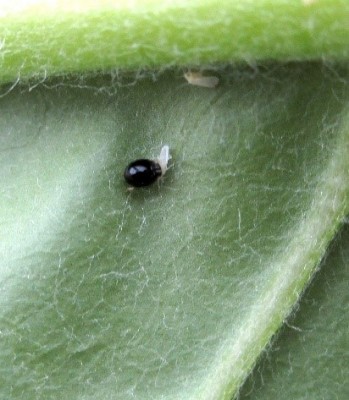Mix and Match: Compatibility of Biocontrol with other Pest Management Strategies

By Amara Dunn, Biocontrol Specialist, NYS Integrated Pest Management Program (arc55@cornell.edu)
Editor's Note: This is an excerpt from a recent post on Amara's blog. The complete posting with images of resources and more details is available at https://blogs.cornell.edu/bioc...
If you were going to tank mix chemical pesticides, you would of course read the label to check for compatibility before mixing products. The same concept applies when using living organisms for pest control. Whether you are using parasitoid wasps, predatory mites, microorganisms, or nematodes, you need to know whether your biocontrols are compatible with each other and any other pest management products you plan to use. For example, a biocontrol fungus might be killed if you tank mix it with (or apply it just before) a chemical fungicide. Insecticides (whether or not they are biological) could be harmful to natural enemy insects and mites. Even some beneficial insects are not compatible with each other because they may eat each other instead of (or in addition to) the pest.
It's a good idea to keep an updated list of the products and organisms you plan to use for pest management, and their compatibility with each other. For biopesticides (remember the difference between "biopesticide" and "biocontrol"?), start by reading the label. You must follow all instructions you find there. Many manufacturers also provide lists, tables, databases, or apps to help you find compatibility information. This is especially useful for insect, mite, and nematode natural enemies, which are not pesticides and do not have pesticide labels. When possible, obtain compatibility information from the manufacturer or supplier you will be using. Different strains of the same microorganism or nematode may have different sensitivities to chemicals.Remember that NY pesticide labels (including biopesticide labels) can be found through the NYSPAD system.
Photo: This small black Delphastus (a predatory beetle) is helping to control whiteflies in a greenhouse. It's important that other pest management strategies in this greenhouse are used in such a way that they do not harm the Delphastus.
Below are some links to resources from several manufacturers and suppliers of biocontrol products. No endorsement of specific companies or products mentioned in this post is intended.
· Beneficial nematodes from BASF
· Compatibility of BioWorks products
· Koppert Side Effects Information
This article is from the May 3, 2018 edition of ENYCHP Vegetable News. To read the full newsletter,CLICK HERE.

Upcoming Events
Wine Sensory Evaluation Workshop
April 26, 2024 : Wine Sensory Evaluation Workshop
Staatsburg, NY
In collaboration with Jeremy Schuster, Viticulture Specialist at the ENYCHP, Dr. Anna Katharine Mansfield and Chris Gerling, Enology Extension Specialists with the Cornell Craft Beverage Institute, will be presenting a wine production-focused, interactive workshop on sensory evaluation.
What is my vine trying to tell me?
May 15, 2024 : What is my vine trying to tell me?
Plattsburgh, NY
Are your grapevines showing signs of discoloration or stunted growth? Don't ignore these warning signs! Join us on May 15th at the Cliton County CCE office to learn about the essential nutrients that grapevines require to thrive, identify the symptoms of nutrient deficiencies, and how to fix them. Don't miss out on this opportunity to improve your grapevine cultivation skills! Attendance is free, but registration is required.
How man's best friend can help find Spotted Lanternfly
May 21, 2024
Millbrook, NY
Come and join us at the Dutchess County CCE office on May 21st for a special demonstration by Jennifer Fimbel, the Agriculture and Horticulture Program Leader with Dutchess County CCE. You will get to see her SLF K9 Cole in action as they demonstrate how man's best friend can be used to detect the Spotted Lanternfly. Attendance is free, but registration is required












































